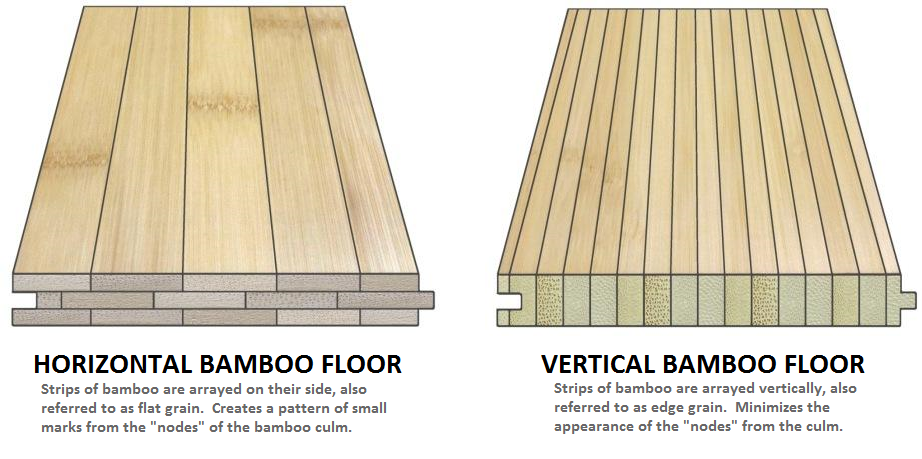When it comes to bamboo flooring, you have the option to choose between horizontal and vertical styles. Each style offers a unique aesthetic appeal and brings its own set of characteristics to your space. In this article, I will provide a straightforward comparison of horizontal and vertical bamboo flooring, helping you make an informed decision that best suits your needs and preferences.
Horizontal Bamboo Flooring: Classic and Natural Beauty
Horizontal bamboo flooring showcases the natural beauty of bamboo with a classic and timeless appeal. The planks are created by arranging bamboo strips horizontally, resulting in a distinct grain pattern. This style provides a warm and rustic look that adds a touch of natural charm to any room. If you appreciate a more traditional and organic aesthetic, horizontal bamboo flooring may be the perfect choice.
Vertical Bamboo Flooring: Sleek and Modern Elegance
Vertical bamboo flooring, on the other hand, offers a sleek and modern look. The bamboo strips are arranged vertically, creating a more consistent and uniform appearance. This style features a clean, contemporary design that complements modern and minimalist interiors. If you prefer a refined and sophisticated ambiance, vertical bamboo flooring can help you achieve that desired effect.
Durability and Stability: A Key Consideration
Both horizontal and vertical bamboo flooring offer excellent durability and stability. Bamboo is known for its strength and resistance to wear and tear. However, it’s important to note that the manufacturing process and the quality of the bamboo flooring can also impact its overall durability. Choose high-quality bamboo flooring from reputable manufacturers to ensure long-lasting performance.
Color Variation and Grain Pattern: Understanding the Differences
One of the primary differences between horizontal and vertical bamboo flooring is the color variation and grain pattern. Horizontal bamboo flooring tends to exhibit a more pronounced grain pattern with visible knots and growth rings. This can create a more rustic and natural look. Vertical bamboo flooring, on the other hand, has a more consistent and uniform appearance with fewer visible grain patterns. The choice between the two styles depends on your preference and your space’s desired aesthetic.
Maintenance and Care: Similar Requirements
Both horizontal and vertical bamboo flooring require similar maintenance and care. Regular sweeping or vacuuming and occasional damp mopping are usually sufficient to keep your bamboo floors clean. Avoiding excessive moisture or harsh chemicals that can damage the bamboo is important. Additionally, using protective pads on furniture legs and avoiding high heels can help prevent scratches on the surface.

Choosing between horizontal and vertical bamboo flooring depends on your personal style preference and the desired aesthetic for your space. Both styles offer unique charm and can bring beauty and durability to your home. By understanding their differences in appearance, maintenance requirements, and installation considerations, you can make an informed decision and select the bamboo flooring that best suits your needs.
Which style is more durable?
Both horizontal and vertical bamboo flooring offer excellent durability. The durability primarily depends on the quality of the bamboo and the manufacturing process. Choosing high-quality bamboo flooring from reputable manufacturers will ensure long-lasting performance regardless of the style.
Can I install bamboo flooring in a moisture-prone area like the bathroom?
While bamboo is more resistant to moisture than hardwood, it is generally not recommended for high-moisture areas like bathrooms. Excessive moisture can still cause damage to the bamboo. It’s best to consult flooring professionals for suitable alternatives for such spaces.
Does bamboo flooring require special maintenance?
Bamboo flooring requires regular maintenance, similar to other hardwood floors. Regular sweeping or vacuuming and occasional damp mopping using a mild cleaner is usually sufficient. Avoid using excessive water or harsh chemicals to protect the bamboo’s finish.
Can I install bamboo flooring over a concrete subfloor?
Yes, bamboo flooring can be installed over a concrete subfloor. However, proper moisture testing and a moisture barrier are essential to prevent moisture-related issues. Professional installation is recommended for optimal results.
Can I refinish bamboo flooring if it gets damaged?
The ability to refinish bamboo flooring depends on the thickness of the wear layer. Thicker wear layers can be sanded and refinished multiple times. However, some bamboo flooring options may have thinner wear layers and may not be suitable for refinishing. It’s important to check the manufacturer’s recommendations for your specific bamboo flooring product.
Engineered vs. Solid Strand Woven Bamboo Flooring Green Goods News
Bamboo Flooring Options – Flooring Company hardwood flooring
Solid Carbonised Vertical Bamboo Flooring 2.21m²
Vertical Grain, Horizontal Grain and Color in Bamboo Flooring
Vertical vs Horizontal Bamboo Floor – Plaster u0026 Disaster u2013 Plaster
Bamboo Flooring Reviews – Horizontal vs Vertical vs Strand Woven
How Much Does It Cost To Install Bamboo Flooring u2013 Forbes Advisor
Solid Natural Vertical Bamboo Flooring 2.21m²
Hot Sale High Quality Natural Carbonize Vertical Horizontal Strand
Bamboo Collection
Related Posts:
- How Much Does It Cost To Install Bamboo Flooring
- Bamboo Flooring Designs
- Maintenance Of Bamboo Flooring
- Average Cost Of Bamboo Flooring
- Commercial Bamboo Flooring
- Modern Bamboo Flooring
- Hand Scraped Strand Woven Bamboo Flooring
- Carbonised Bamboo Flooring
- Bamboo Floor Care Maintenance
- Can Bamboo Flooring Be Used In A Bathroom?









